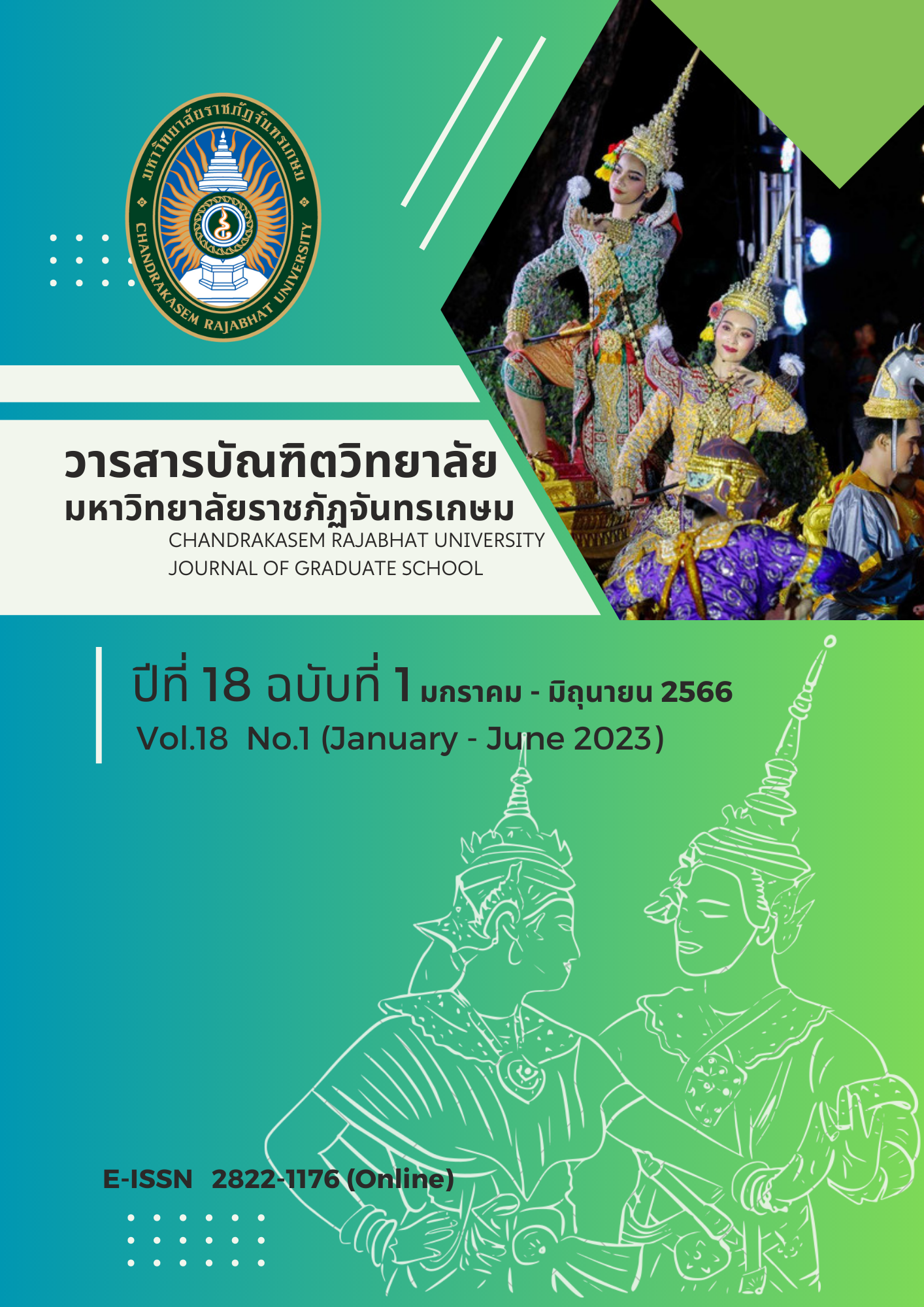กลวิธีการรำตรวจพลของอสุรผัดในการแสดงโขน
Main Article Content
บทคัดย่อ
งานวิจัยเรื่อง กลวิธีการรำตรวจพลของอสุรผัดในการแสดงโขน มีวัตถุประสงค์เพื่อ (1) ศึกษาประวัติความเป็นมาและบทบาทของอสุรผัดในการแสดงโขน (2) ศึกษากลวิธีการรำตรวจพลเฉพาะตัวของอสุรผัดในการแสดงโขน โดยศึกษาจาก คุณครูประสิทธิ์ ปิ่นแก้ว ศิลปินแห่งชาติ ปี พ.ศ. 2551 สาขาศิลปะการแสดง (นาฏศิลป์-โขน) ผู้เชี่ยวชาญการสอนนาฏศิลป์ไทย (โขนลิง) วิทยาลัยนาฏศิลป์ สถาบันบัณฑิตพัฒนศิลป์ ตามแนวทางของคุณครูกรี วรศะริน ศิลปินแห่งชาติ สาขาศิลปะการแสดง (นาฏศิลป์-โขน) ปี พ.ศ. 2531 มีวิธีการดำเนินการวิจัยเชิงคุณภาพ โดยศึกษาเอกสารและงานวิจัยที่เกี่ยวข้อง การลงภาคสนามเพื่อฝึกปฏิบัติท่ารำ การสัมภาษณ์ผู้เชี่ยวชาญ ผู้ทรงคุณวุฒิด้านนาฏศิลป์ไทยการวิเคราะห์ข้อมูลใช้การวิเคราะห์เชิงเนื้อหา
ผลการศึกษาพบว่า (1) อสุรผัด ถือกำเนิดจาก หนุมาน (ลิง) ผู้เป็นพ่อ และนางเบญกาย (นางยักษ์) ผู้ที่เป็นแม่จึงทำให้ลักษณะพิเศษและแตกต่างจากตัวละครอื่น เนื่องจากเป็นตัวละครลูกผสมระหว่างยักษ์กับลิง มีลักษณะกายและผมเป็นยักษ์ ลักษณะใบหน้าเป็นลิง กายสีขาว สวมกรอบพักตร์ อสุรผัดมีบทบาทที่สำคัญ คือ เป็นทหารของพระพรตและพระสัตรุต เป็นลูก เป็นหลานท้าวทศคีรีวงศ์ (2) ผลจากการศึกษาการรำกราวตรวจพลอสุรผัดในการแสดงโขนแบ่งออกเป็น 2 ช่วง ช่วงที่ 1 การศึกษาท่ารำจากคุณครูประสิทธิ์ ปิ่นแก้ว ซึ่งได้รับการถ่ายทอดโดยตรงจากคุณครูกรี วรศะริน มีทั้งหมด 39 ท่ารำ และช่วงที่ 2 การศึกษาท่ารำที่ได้ปรับปรุงเพื่อใช้ในการเรียนการสอนตามหลักสูตรนาฏศิลป์ชั้นกลาง พ.ศ. 2524 โดยศึกษากระบวนท่ารำกราวยักษ์ฉากที่ 1 มาเป็นแนวทางในการออกแบบท่ารำกราวตรวจพล ส่วนท่ารำตรวจพลอสุรผัดที่ศึกษาจากคุณครูประสิทธิ์ ปิ่นแก้ว ช่วงแรกจะเป็นท่าลิงแต่มีท่าทางเป็นยักษ์ คุณครูประสิทธิ์ ปิ่นแก้ว ได้ปรับปรุงขึ้นใหม่ โดยการนำกระบวนท่ารำกราวยักษ์ฉากที่ 1 เข้ามาใช้ในออกแบบท่ารำซึ่งมีจำนวนถึง 39 ท่า ประกอบด้วยกระบวนท่าคล้ายกับหนุมานทรงเครื่องออกกราว มือกระทบ มือเข้าอก เข้าตรวจพลแล้วลานั่ง
Article Details

อนุญาตภายใต้เงื่อนไข Creative Commons Attribution-NonCommercial-NoDerivatives 4.0 International License.
เอกสารอ้างอิง
ไกรลาส จิตร์กุล (2548).การตรวจพลของพญาวานรในการแสดงโขน. (ปริญญานิพนธ์ปริญญาศิลปศาสตรมหาบัณฑิต). จุฬาลงกรณ์มหาวิทยาลัย, กรุงเทพมหานคร.
ประเมษฐ์ บุณยะชัย. ศิลปินแห่งชาติ ผู้เชี่ยวชาญนาฏศิลป์ไทย โขนยักษ์ สถาบันบัณฑิตพัฒนศิลป์. (ผู้ให้สัมภาษณ์) ขรรค์ชัย หอมจันทร์. (ผู้สัมภาษณ์) เมื่อ 5 กันยายน 2565.
มัทนี รัตนิน. (2546). ความรู้เบื้องต้นเกี่ยวกับศิลปะการกำกับการแสดงละครเวที. กรุงเทพฯ: สำนักพิมพ์มหาวิทยาลัยธรรมศาสตร์.
สมศักดิ์ ทัดติ. ผู้เชี่ยวชาญนาฏศิลป์ไทย โขนยักษ์ สถาบันบัณฑิตพัฒนศิลป์. (ผู้ให้สัมภาษณ์) ขรรค์ชัย หอมจันทร์. (ผู้สัมภาษณ์) เมื่อ 5 กันยายน 2565.
ศิลปากร, กรม. (2545). ตำราพิไชยสงครามฉบับรัชกาลที่ 1. กรุงเทพฯ: กรมศิลปากร.
วันทนีย์ ม่วงบุญ. (2539). ลักษณะประติมานวิทยาของหุ่นเรื่องรามเกียรติ์. กรุงเทพฯ: สถาบันนาฏดุริยางคศิลป์ กรมศิลปากร.
อมรา กล่ำเจริญ. (2526). สุนทรีนาฏศิลป์ไทย. กรุงเทพฯ: โอเดียนสโตร์.


